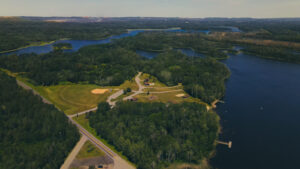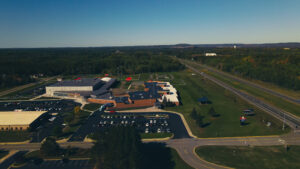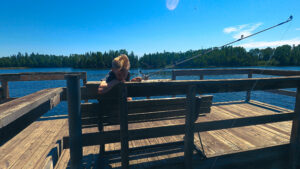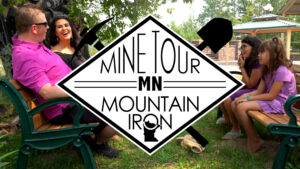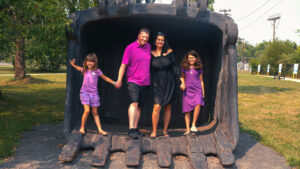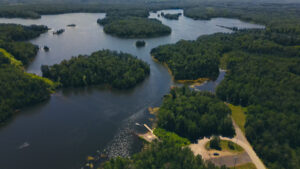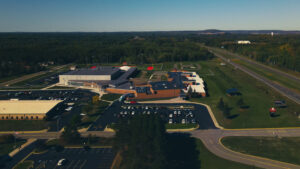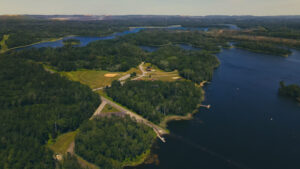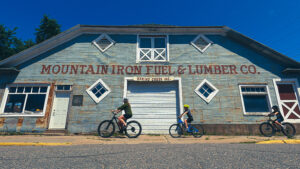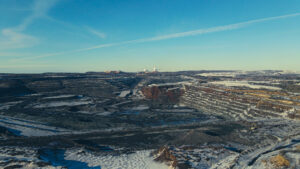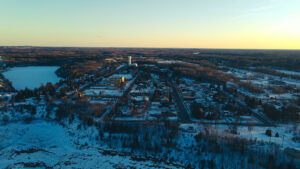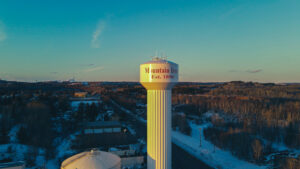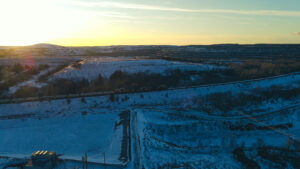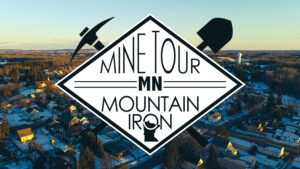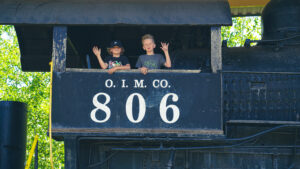Mountain Iron – Opening a New Era
The city of Mountain Iron is known as the ”Birthplace of the Mesabi,” because it was here that the first iron ore of the Mesabi Iron Range was discovered, and, here that the railroad transported the first shipment of ore in 1892. Today it is home to U.S. Steel’s MINNTAC, the largest taconite processing facility in the world.
Although the actual discovery of ore on the Mesabi Iron Range could never be attributed to one individual, it is commonly believed that, although the discovery was inevitable, it came when it did as a result of the achievements of the Merritt brothers, the “Seven Iron Men”.
Lewis H. Merritt and his wife, Hephzibah were the parents of eight sons; Andrus, Cassius, Lewis J., Alfred, Leonidas, Lucien, Napoleon and Jerome. In July of 1885, Lewis H., a millwright and carpenter by trade, traveled to Oneota, West Duluth today, to supervise construction of a sawmill, the first sawmill in the area. His wife and children, ages 2-22, arrived in October, 1886.
It is difficult to imagine today what the Merritt family would have experienced when they arrived in Oneota. Their son, Alfred, would recall many years later, “What a beautiful sight it was…no axe having marred nature…there being hardly a tree cut, from Minnesota Point to Fond-du-Lac.” How amazing it would have been to experience the area before all the majestic timber was swept away. In fact, the Merritt brothers were known only as “expert timber cruisers”, not prospectors, when they arrived.
Our nation’s early insatiable desire for wood, would lead to a virtual tsunami wave of wanton timber harvesting beginning in the east, making its way across Michigan, Wisconsin, and finally to Minnesota. As resources became increasingly scarce, Eastern Lumber Barons had northeastern Minnesota’s lumber in their sights. Many arrived and purchased large swaths of cheap land unaware that the real riches lay underneath their feet.
Lewis H. would get caught up in the Gold Rush of 1865-66. Traveling to the Vermilion Range where the word was out that gold could be found, Lewis had noted ore outcroppings exposed on the Mesabi. When he returned home, he shared with his sons his belief in the rich potential of the area he had seen. Outside land speculators quickly secured the ore lands of the Vermilion, so potential explorers of that area shifted their attention to the Mesabi Range where land was still available.
The Merritts did not believe the Chester Survey reports of 1875 condemning the Mesabi ore as “too lean” in its iron content, so they explored the Mesabi hills pursuing their dream of discovery and wealth. In 1889, they hired Michigan mine expert Captain J. A. Nichols and on July 11, 1890, organized the Mt. Iron Company, capitalized at two million dollars.
With Leonidas taking the leadership position, the Merritt brothers’ determination would finally payoff when on November 16, 1890, Nichols discovered soft, red, hematite in a test pit close to where the city of Mountain Iron stands today. The ore assayed at sixty-seven percent iron and was so soft it could be shoveled right out of the ground. The mine was the first body of soft ore discovered and mined on the Mesabi Iron Range. Their father, Lewis, who died in 1880, was not there to witness his children’s success.
Expanding their holdings, the Merritts obtained as many as 141 leases, most on state land, under a law that authorized such transactions with the condition that twenty-five cents per ton be paid to the state.
From 1889 to 1892, Mountain Iron was an exploration camp “beyond the fringes of civilization.” Once ore was discovered, Mountain Iron, like many other locations across Iron County, became a place to house mine employees and started to lose its temporary appearance. By mere days, Mesaba, Grand Rapids, Merritt, Mckinley, Biwabik and Virginia were all incorporated before Mountain Iron, which incorporated November 28, 1982. The Mesabi Range was beginning to boom.
In 1892, the Merritt’s would make a critical decision to expand their business by building the Duluth, Missabe, and Northern railroad to reach Duluth where they hoped to compete with the ore shipments from the Vermilion Range. They needed additional funding for the project and negotiated a deal with John D. Rockefeller. This would be a decision they would come to regret.
The financial panic of 1893 hit America’s developing industrial economy extremely hard. Only those individuals with exceptional assets and wealth would survive this financialupheaval. John D. Rockefeller was one of these individuals; the Merritts were not. After many unsuccessful lawsuits against Rockefeller with no success, the Merritts finally settled and were left with virtually nothing. Such was the unpredictable nature of life on the Iron Range, fortunes were won and lost, towns came and went. The people that lived and worked in this boom and bust environment developed a strong, determined and unique character that survives to this day.
As a town on the Mesabi, Mountain Iron was somewhat slow to develop, although ore production was on fire. By 1900, almost 4 million tons of ore had been shipped from the Mountain Iron Mine alone and it continued to ship immense amounts of ore until well into the 20th century.
The Mining Company was extremely involved in Mountain Iron and may be the reason it had a reputation of being one of the more orderly towns on the range. A jail, fire hall, four churches and a “commodious public school building: were all added to the townsite. Maybe the critical factor was that only three saloons were allowed, nearby Virginia had 52!
Other critical amenities were slow to follow. In 1910, residents were still carrying water to their homes from the mine pumping stations. The town didn’t have a sewage disposal system or an electric light plant until 1912. 1912 was a time of rapid town improvements. An all brick two-story city hall building with a jail and fire department was completed. This was followed by an elegantly finished Carnegie public library,
paved streets, a nine-acre park and a public lighting system equal to any on the range.
During the fiftieth anniversary of the discovery of iron ore on the Mesabi Range, a ten and one half foot granite and cement statue of Leonidas Merritt, leader of the Merritt family, was unveiled. That statue stands today on the grounds of Mountain Iron’s public library, a tribute to the spirit and determination that helped build the Mesabi Iron Range.
At the Minntac Mine Overlook, just south of town, visitors have a unique chance to view Minntac/U.S. Steel operations.
Mountain Iron Mine was proclaimed a National Historic Landmark in 1968 and subsequently listed on the National Register of Historic Places for its national significance in the theme of industry.[5] The property was nominated for setting in motion the extraction of iron ore on the Mesabi Range, which helped make Minnesota the nation’s largest iron producer and the United States the world’s largest steel manufacturer.
The community is adjacent to Virginia and offers many shared attractions. The eastern edge of Mountain Iron and the western edge of Virginia share the Highway 53 corridor and the “service belt” that runs along it. All these services are within walking or biking distance from the Mesabi Trail which has an access point and parking located at Locomotive Street and Mesabi Avenue.
In downtown Mt. Iron on Locomotive Street, there is a “must stop” for all train enthusiasts. The Mountain Iron Locomotive Park features a 1910 Baldwin locomotive, class S-4 switcher on display and is situated near the site where iron ore was first discovered in this region. Like an open-air museum, outdoor display panels depict the mining process. Picnic area on site.
The Leonidas Merritt Days festival happens every August with fun and games for the whole family.
Minntac at-a-glance – 9 miles long | 1.9 miles at widest point | 435 feet deep
- Located in Mountain Iron, Minnesota, the Minntac facility began operations in 1953 as Pilotac.
- Minntac processes 2.2 billion tons of crude ore to produce 16 million net ton of iron pellets annually.
- Around 30% of the original crude feed becomes product. Remaining products are used to build roads or directed to the tailings basin, which purifies and reclaims 96% of the water used on site.
- The facility has 46 crushers and 11.5 miles of conveyor belts to move iron through three stages of crushing







